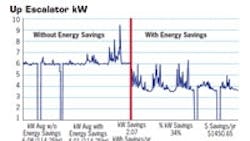Less power for lighter loads
Back in the 1980s, a NASA engineer named Frank Nola came up with a way of controlling the power to an induction motor as a means of saving energy. Nola sensed voltage and current within a motor to gauge its load. When his circuit sensed the motor was lightly loaded, it would chop out a portion of the input voltage waveform without slowing down the motor.
The idea worked pretty well unless the motor suddenly saw a heavier load. So says BJ Lackland, CFO of Power Efficiency Corp. (PEC), the company that acquired the Nola patents. Lackland tells the story of an early installation at a saw mill. On a saw blade motor, Nola's controller shrank power consumption significantly while the blade spun freely. But it stalled on the first bite into a log. Before he was shown the door, the hapless motor control salesman was forced to free the blade with an axe and yank out the control box.
These days, embarrassments like this are a thing of the past for the company. Venture capitalists got involved with PEC, says Lackland, and did the R & D needed to work the bugs out of Nola's ideas, applying for three patents in the process.
The technology is now dubbed E-Save. Nola's basic ideas are still there: Zero-out a portion of each ac waveform half cycle to reduce the RMS value. But now the controller does a “balancing act,” covered by the company's patents, giving the motor enough power to maintain its normal operating speed when loaded.
Motors run from the old Nola circuit also tended to go into an unstable vibration mode under certain conditions. PEC solved this problem with a balanced and synchronized phased detector that smooths out the motor voltage signal at the comparator that is the heart of the Nola device. Lackland says this phase detector virtually elements vibrations when the motor operates and lets E-Save controllers work on a much broader range of motors than other devices based on the Nola circuit.
To manage difficulties responding to rapid increases in the load, the controller incorporates a proprietary “fast response” algorithm that lets it apply full power when required. And because the controller handles operating setpoints in software, it can control the degree to which the device delivers power to the motor for individual applications as the need arises. This also lets the device function as a configurable soft-starter.
One key advantage of the technology is that it can be less expensive than a variable-speed drive. That's because, in contrast to a VFD, the controller doesn't convert ac to dc and then back to ac in the process of powering the motor. Instead, it just uses a thyristor or switching element for each motor phase winding, and simply decides on the sequence for firing the thyristors depending on power needs.
PEC is quick to point out that because its controller reduces motor torque, the technology is appropriate for applications that require a constant speed but not constant torque. (Motors with an E-Save controller may slow by a couple of rpm at most under load, says Lackland.) That puts applications such as newspaper printing presses, which require constant torque, pretty much off-limits. But applications that are fair game include escalators, crushers, grinders, many types of conveyors, mixers, and shredders.
Resources
Power Efficiency Corp., www.powerefficiency.com
